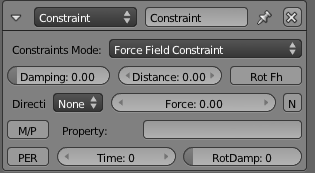Constraints Actuator¶
See also
See the Python reference of this logic brick in KX_ConstraintActuator.
The Constraints Actuator adds a constraint to the location or orientation of an object. This is useful for controlling the physics of the object in-game.
Properties¶
- Constraint Mode
Constraint type to use. Each is described below.
Force Field Constraint¶
Create a force field buffer zone along one axis of the object.

Force Field Constraint.¶
- Damping
Damping factor of the Fh spring force.
- Distance
Height of Fh area.
- Rot Fh
Make game object axis parallel to the normal of trigger object.
- Direction
Axis in which to create force field (can be + or -, or None).
- Force
Force value to be used.
- N
When on, use a horizontal spring force on slopes.
- M/P
Trigger on another Object will be either Material (M) or Property (P).
- Property
Property/Material that triggers the Force Field constraint (blank for all Properties/Materials).
- Per
Persistence button When on, force field constraint always looks at Property/Material; when off, turns itself off if it cannot find the Property/Material.
- Time
Number of frames for which constraint remains active.
- RotDamp
Damping factor for rotation.
Orientation Constraint¶
Constrain the specified axis in the Game to a specified direction in the World axis.

Orientation Constraint.¶
- Direction
Game axis to be modified (X, Y, Z or none).
- Damping
Delay (frames) of the constraint response.
- Time
Time (frames) for the constraint to remain active.
- Reference Direction
Reference direction (global coordinates) for the specified game axis.
- Min Angle
Minimum angle for the axis modification.
- Max Angle
Maximum angle for the axis modification.
Distance Constraint¶
Maintain the distance the Game Object has to be from a surface.

Distance Constraint.¶
- Direction
Axis Direction (X, Y, Z, -X, -Y, -Z, or None).
- L
If on, use local axis (otherwise use World axis).
- N
If on, orient the Game Object axis with the mesh normal.
- Range
Maximum length of ray used to check for Material/Property on another game object.
- Force Distance
Distance to be maintained between object and the Material/Property that triggers the Distance Constraint.
- Damping
Delay (frames) of the constraint response.
- M/P
Trigger on another Object will be either Material (M) or Property (P).
- Property
Property/Material that triggers the Force Field constraint (blank for all Properties/Materials).
- Per
Persistence button: When on, force field constraint always looks at Property/Material; when off, turns itself off if it cannot find the Property/Material.
- Time
Number of frames for which constraint remains active.
- Rotation Damping
Damping factor for rotation.
Location Constraint¶
Limit the position of the Game Object within one World Axis direction. To limit movement within an area or volume, use two or three constraints.

Location Constraint.¶
- Limit
Axis in which to apply limits (LocX, LocY, LocZ or none).
- Min
Minimum limit in specified axis (Blender Units).
- Max
Maximum limit in specified axis (Blender Units).
- Damping
Delay (frames) of the constraint.